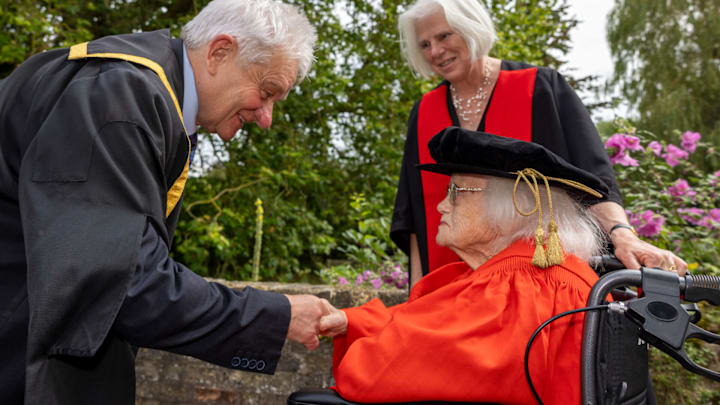A British university has bestowed an honorary doctorate of science on 98-year-old Rosemary Fowler, 75 years after she made a discovery that helped revolutionize particle physics.
In 1948, Fowler—then Rosemary Brown—was a Ph.D. student at the University of Bristol, working in the lab of future Nobel laureate C.F. Powell.
Back then, the best way to glimpse at some of the elusive particles of interest was by sending a highly sensitive colloid on a photographic plate up to a high altitude. While Fowler reviewed a slide of one of these photographic emulsions, she noticed that one particle had decayed into three subatomic particles, called “pions.” This defied what was then a widely accepted concept of physics known as parity. To grossly oversimplify its definition from a longer explanation—like the one laid out by Nature writer Suzie Sheehy here—parity held that physical processes like the one on the slide should have a mirror-like symmetry. So how could there be an uneven number of pions?

Fowler was the lead author on a series of papers documenting the phenomenon. Over the next few years, the odd pattern created a puzzle until physicists accepted that particle patterns do not hold parity in states of decay. The mysterious particle that Fowler had discovered was named the kaon. The research instigated a series of new theories and equations that led to the confirmation of the Higgs boson particle in 2012. The Higgs boson, previously theoretical, was observed at an energy lab in Geneva and is responsible for granting other particles their mass, making it a building block of our modern understanding of particle physics.
But Fowler did not participate in that exchange of ideas. She left the university to marry a classmate in the physics department, Peter Fowler, in 1949 and focused on raising three daughters, all of whom went on to study science. In post-war Britain, a statement from the University of Bristol said it would have been particularly tough to navigate life with two parents in the workforce at the time.
Fowler accepted the honor at a ceremony at Darwin College, Cambridge, surrounded by children, grandchildren, and great-grandchildren, and said she felt “very honored ... but I haven’t done anything since to deserve special respect.”
Read More Fascinating Facts About Physics:
